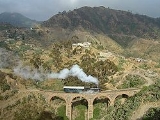
Eritrean Railway
Encyclopedia
The Eritrean Railway is the only railway system in Eritrea
. It was constructed between 1887 and 1932 by the Kingdom of Italy
for the Italian colony of Eritrea, and connected the port of Massawa
with Bishia
near the Sudan
border. The line was essentially destroyed by warfare in subsequent decades, but has been rebuilt between Massawa and Asmara
. Vintage equipment is still used on this line.
and Asmara
, the main cities of Italian Eritrea.
In the 1930s Italian leader Benito Mussolini
wanted to reach Kassala
in Sudan, but his war to conquer Ethiopia
and create the Italian Empire
stopped the enlargement to Agordat
and Bishia.
After damage suffered by the railway during World War II
, the section between Massawa and Asmara was dismantled partially and was only rebuilt in the 1990s by the Eritrean authorities.
The railway is narrow gauge and is slowly being rebuilt after the devastation wreaked upon it by the war of independence
.
It still manages to operate, however, despite its newest equipment being nearly fifty years old, with most of it predating World War II.
It is one of the few railway systems still in existence (excluding tourist railways
) using equipment like the 1930s Italian-built 'Littorina' railcar
s behind 1930s-vintage Mallet steam locomotives
.
chosen was the Italian standard narrow gauge measurement of , similar to many common narrow gauge railways under construction in Italy at the same time.
What with the short building time and the simultaneous flow of some common equipment and materials to the national railway yards, e.g. metallic plate ties
(sleepers), it was necessary to acquire these from France to some extent.
A previous Italian law from 1879 officially established the track gauges, which specified the use of 1500 millimetre, 1000 millimetre and 750 millimetre gauge track measured from the centre of the rails, or , and , respectively, on the inside faces.
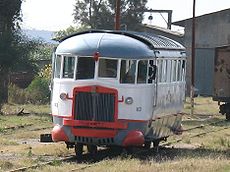 Construction began from the Red Sea port city of Massawa in 1887, heading towards the capital city of Asmara
Construction began from the Red Sea port city of Massawa in 1887, heading towards the capital city of Asmara
. Progress was slow, thanks to the long climb up the mountains to the high plateau of inland Eritrea, and the substantial civil engineering works required; the line reached Asmara in 1911. It was extended to Keren
in 1922, Agat in 1925, Agordat
in 1928, and finally Bishia in 1932, for a total length of 280 km (174 mi). Bishia (Biscia in Italian) proved to be the end, even though the builders had ambitions of reaching the Sudan Railways line. Benito Mussolini
's invasion of Ethiopia
led to resources being diverted elsewhere, including the upgrading of the line from Massawa to Asmara to handle more traffic.
Building the line from Massawa to Asmara was a significant undertaking. Even with the tighter turns and narrower right-of-way allowed by a narrow gauge railway, the line required 65 bridges (including a fourteen-arch viaduct crossing the Obel River
) and 39 tunnels, the longest being 320 m (1,050 ft). Even so, there were still grades of more than 3%. The highest point on the railway is just east of Asmara at 2394 m (7,854 ft) above sea level.
The construction of the railway was considered worldwide as a renowned achievement of the first half of the twentieth century.
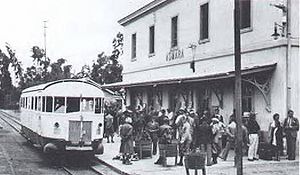 The railway was reasonably busy for such a small line; in 1935, carrying large quantities of supplies for the Italian war effort in Ethiopia, the line saw 30 trains daily, while by 1965 the line was carrying nearly half a million passengers a year as well as 200,000 tons of freight. Things went downhill progressively from there. Improvements, to the road from Massawa to Asmara and to the trucks and buses that used it, began to take traffic away from the railway.
The railway was reasonably busy for such a small line; in 1935, carrying large quantities of supplies for the Italian war effort in Ethiopia, the line saw 30 trains daily, while by 1965 the line was carrying nearly half a million passengers a year as well as 200,000 tons of freight. Things went downhill progressively from there. Improvements, to the road from Massawa to Asmara and to the trucks and buses that used it, began to take traffic away from the railway.
Until 1941, the railway was Italian controlled, but the fortunes of war allowed the British to take control. After 1942 the railway (damaged during the British occupation
and by Italian guerrillas
) was abandoned from Agordat
to Biscia.
In 1942 the British moved some diesel locomotives and materials to Eritrea when they dismantled the Railway Mogadiscio-Villabruzzi
of Italian Somalia. In 1944 the British (as a war compensation) dismantled the Italian-built Asmara-Massawa Cableway
that supplemented the railway as a means of transportation inland.
In 1953 Eritrea was joined to Ethiopia in Federation as the British pulled out, giving Ethiopia a coastline, but starting off 40 years of unrest and eventually war.
The 1950s and 1960s were successful years for the railway, but the 1970s saw the railway fall more and more out of use as the unrest intensified, and in 1975 the railway was destroyed by the ruling Derg
regime in Ethiopia. Much of the infrastructure was destroyed during the following years of war, and both sides used materials salvaged from the railway for fortification and other purposes.
At the same time, restoration began on the remaining locomotives and rolling stock remaining after the conflict. Eleven steam locomotives survived, and at least six have been rebuilt to working order. In addition, several 1930s vintage Fiat 'Littorina' railcars survive and have been made operational, as well as two 1957 Krupp built Bo-Bo diesels (the line's newest locomotives) and one of three surviving Drewry shunters, brought to the railway by the British during the war years. Finally, several road trucks have been converted to run on rail wheels. Much freight stock and a number of passenger cars also survive.
The line has now been restored from Massawa all the way through to Asmara, but no scheduled services traverse the whole length of the line. Charter trains for tourists now do, and regular train services exist in certain areas where there is demand. While the surviving equipment is sufficient for such a limited service, the purchase or building of more is necessary to provide a serious form of transportation over the length of the line. The Eritrean Railroad Authority has requested funding to continue the Italian-era plan to extend the route to Tesseney and provide an opportunity for Sudan to efficiently use the Port of Massawa. Mining companies in Eritrea have also inquired about use of the railway and its improvement.
A small fleet of more modern rail cars could provide more serious competition to the current bus services. The surviving freight cars include a number of larger boxcars suitable for a limited freight service.
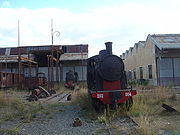 These small 0-4-0 tank engines were and are the standard shunter locomotives of the system, built between 1927 and 1937 by the firm of Breda
These small 0-4-0 tank engines were and are the standard shunter locomotives of the system, built between 1927 and 1937 by the firm of Breda
in Milan
. They have short side tanks, a rear coal bunker, and a unified, oval dome containing the steam dome inside a larger sand dome - this arrangement, popular worldwide in nations that favored the sand dome, helped both to insulate the steam dome and to keep the sand dry with the warmth. Large, prominent builder's plates adorn the domes. They utilise Walschaerts valve gear with piston valves
and superheating
, and are painted in the traditional European style of red below the running board, including frames and wheels, and black above, including boiler, cab, tanks etc. The purpose of the red paint is to make cracks and breakages in the locomotive's important running gear more obvious.
Six of these engines still survive, of which two were in running order and four in storage awaiting restoration.
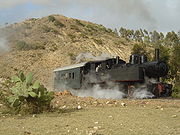 One of these early Mallet locomotives, which is a true Mallet and thus a compound, still exists in storage at the Asmara workshops. It was a 1915 product of Ansaldo
One of these early Mallet locomotives, which is a true Mallet and thus a compound, still exists in storage at the Asmara workshops. It was a 1915 product of Ansaldo
in Genova.
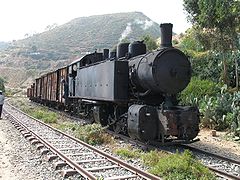 These are the prime main-line steam locomotives of the railway, and are in high demand for tourist services. Two of them, double headed, are required to scale the steepest grades with a train of any length. Like the other locomotives they are tank engines with large side tanks and a rear coal bunker, under cover of the cab roof in this design. These are quite hefty machines, as required by the tough demands of the terrain.
These are the prime main-line steam locomotives of the railway, and are in high demand for tourist services. Two of them, double headed, are required to scale the steepest grades with a train of any length. Like the other locomotives they are tank engines with large side tanks and a rear coal bunker, under cover of the cab roof in this design. These are quite hefty machines, as required by the tough demands of the terrain.
-built Bo-Bo roadswitchers of typical German offset-cab design in 1957, the newest motive power owned by the system and the only locomotives purchased after World War II. They are both still in working order and when the line's replacement is complete it is intended to use them for hauling freight. They are painted in a creamy white with brown frames and trucks.
built shunters are owned by the railway, and were brought to Eritrea by the British after their takeover in 1941. They were previously in service in the Sudan
and were of a slightly wider gauge there; they were regauged to the railway's gauge by turning them from an outside framed to an inside framed layout. Two are 0-6-0s and one is an 0-4-0; one of each is working while the third is under repair. They are painted in the same scheme as the Krupp units, and recent photographs show that they are lacking their bonnet sides and the engines are exposed.
-built 'Littorina' railcars survived the civil war and two are in working order. They are attractive looking, rounded things, very Art Deco
in style, with large Fiat radiators on the front. The bodies are painted in creamy white with grey underneath and roofs with red 'bumpers' on the ends and a red stripe separating the body color from the grey below, which looks quite attractive. They are intended for tourist service; new vehicles will be built or bought for regular passenger service.
In addition, one 4-wheel railcar built by Brown Boveri of Switzerland exists out of service in the Asmara shops, which was apparently being used as a mobile generator car before the civil war.
For maintenance an improvised maintenance car is used, a four-wheeler built from a motor-cycle.
, survive. They are fitted with wooden seats and have a platform at each end, one of which is for the brakeman
— there are no continuous train brakes on the railway, and braking is either done with the locomotive's brakes or by manually applying the brakes on each car. They are now painted in an attractive livery of white with pale blue in a stripe above the windows and at the bottom of the bodywork.
of the Eritrean Railway appears to be quite small. Therefore two test runs, one in 2006 another one in spring 2010 took place when ISO containers
were successfully carried on traditional flat wagons
through all the tunnels along the line. In December 2010 two ISO Containers of Maersk Line with equipment donated by the Danish State Railway for the rail workshops in Asmara travelled all the line with no problems. It is not clear if the containers were 8 in 0 in (2,438.4 mm) high or 9 in 6 in (2,895.6 mm) high. The loading gauge
diagram would indicate that the latter may be problematic.

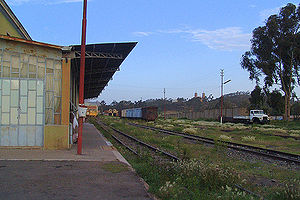 The railway was fully opened in 1932, and ran from the port of Massawa westwards to Asmara, then extending northwards to Keren, Agordat and Bishia. As of 2009, the 118 kilometres (73.3 mi) section between Massawa and Asmara is open.
The railway was fully opened in 1932, and ran from the port of Massawa westwards to Asmara, then extending northwards to Keren, Agordat and Bishia. As of 2009, the 118 kilometres (73.3 mi) section between Massawa and Asmara is open.
Eritrea
Eritrea , officially the State of Eritrea, is a country in the Horn of Africa. Eritrea derives it's name from the Greek word Erethria, meaning 'red land'. The capital is Asmara. It is bordered by Sudan in the west, Ethiopia in the south, and Djibouti in the southeast...
. It was constructed between 1887 and 1932 by the Kingdom of Italy
Kingdom of Italy (1861–1946)
The Kingdom of Italy was a state forged in 1861 by the unification of Italy under the influence of the Kingdom of Sardinia, which was its legal predecessor state...
for the Italian colony of Eritrea, and connected the port of Massawa
Massawa
Massawa, also known as Mitsiwa Massawa, also known as Mitsiwa Massawa, also known as Mitsiwa (Ge'ez ምጽዋዕ , formerly ባጽዕ is a city on the Red Sea coast of Eritrea. An important port for many centuries, it was ruled by a succession of polities, including the Axumite Empire, the Umayyad Caliphate,...
with Bishia
Bishia
- Transport :It is the end of the railway line from Asmara, though the line did briefly extend through to Sudan.- References :...
near the Sudan
Sudan
Sudan , officially the Republic of the Sudan , is a country in North Africa, sometimes considered part of the Middle East politically. It is bordered by Egypt to the north, the Red Sea to the northeast, Eritrea and Ethiopia to the east, South Sudan to the south, the Central African Republic to the...
border. The line was essentially destroyed by warfare in subsequent decades, but has been rebuilt between Massawa and Asmara
Asmara
Asmara is the capital city and largest settlement in Eritrea, home to a population of around 579,000 people...
. Vintage equipment is still used on this line.
Characteristics
Originally the railway was built by the Italians in order to connect MassawaMassawa
Massawa, also known as Mitsiwa Massawa, also known as Mitsiwa Massawa, also known as Mitsiwa (Ge'ez ምጽዋዕ , formerly ባጽዕ is a city on the Red Sea coast of Eritrea. An important port for many centuries, it was ruled by a succession of polities, including the Axumite Empire, the Umayyad Caliphate,...
and Asmara
Asmara
Asmara is the capital city and largest settlement in Eritrea, home to a population of around 579,000 people...
, the main cities of Italian Eritrea.
In the 1930s Italian leader Benito Mussolini
Benito Mussolini
Benito Amilcare Andrea Mussolini was an Italian politician who led the National Fascist Party and is credited with being one of the key figures in the creation of Fascism....
wanted to reach Kassala
Kassala
Kassala is the capital of the state of Kassala in eastern Sudan. Its 2008 population was recorded to be 419,030. It is a market town and is famous for its fruit gardens. It was formerly a railroad hub, however, as of 2006 there was no operational railway station in Kassala and much of the track...
in Sudan, but his war to conquer Ethiopia
Ethiopia
Ethiopia , officially known as the Federal Democratic Republic of Ethiopia, is a country located in the Horn of Africa. It is the second-most populous nation in Africa, with over 82 million inhabitants, and the tenth-largest by area, occupying 1,100,000 km2...
and create the Italian Empire
Italian Empire
The Italian Empire was created after the Kingdom of Italy joined other European powers in establishing colonies overseas during the "scramble for Africa". Modern Italy as a unified state only existed from 1861. By this time France, Spain, Portugal, Britain, and the Netherlands, had already carved...
stopped the enlargement to Agordat
Agordat
Agordat is a city in Eritrea. It was the former capital of the now defunct Barka Province of Eritrea .- Overview :...
and Bishia.
After damage suffered by the railway during World War II
World War II
World War II, or the Second World War , was a global conflict lasting from 1939 to 1945, involving most of the world's nations—including all of the great powers—eventually forming two opposing military alliances: the Allies and the Axis...
, the section between Massawa and Asmara was dismantled partially and was only rebuilt in the 1990s by the Eritrean authorities.
The railway is narrow gauge and is slowly being rebuilt after the devastation wreaked upon it by the war of independence
Eritrean War of Independence
The Eritrean War of Independence was a conflict fought between the Ethiopian government and Eritrean separatists, both before and during the Ethiopian Civil War. The war started when Eritrea’s autonomy within Ethiopia, where troops were already stationed, was unilaterally revoked...
.
It still manages to operate, however, despite its newest equipment being nearly fifty years old, with most of it predating World War II.
It is one of the few railway systems still in existence (excluding tourist railways
Heritage railway
thumb|right|the Historical [[Khyber train safari|Khyber Railway]] goes through the [[Khyber Pass]], [[Pakistan]]A heritage railway , preserved railway , tourist railway , or tourist railroad is a railway that is run as a tourist attraction, in some cases by volunteers, and...
) using equipment like the 1930s Italian-built 'Littorina' railcar
Railcar
A railcar, in British English and Australian English, is a self-propelled railway vehicle designed to transport passengers. The term "railcar" is usually used in reference to a train consisting of a single coach , with a driver's cab at one or both ends. Some railways, e.g., the Great Western...
s behind 1930s-vintage Mallet steam locomotives
Mallet locomotive
The Mallet Locomotive is a type of articulated locomotive, invented by a Swiss engineer named Anatole Mallet ....
.
The 950 mm gauge
Eritrea was an Italian colony, and accordingly its railway was built by Italian engineers to Italian standards, using equipment bought from Italy. The gaugeRail gauge
Track gauge or rail gauge is the distance between the inner sides of the heads of the two load bearing rails that make up a single railway line. Sixty percent of the world's railways use a standard gauge of . Wider gauges are called broad gauge; smaller gauges, narrow gauge. Break-of-gauge refers...
chosen was the Italian standard narrow gauge measurement of , similar to many common narrow gauge railways under construction in Italy at the same time.
What with the short building time and the simultaneous flow of some common equipment and materials to the national railway yards, e.g. metallic plate ties
Railroad tie
A railroad tie/railway tie , or railway sleeper is a rectangular item used to support the rails in railroad tracks...
(sleepers), it was necessary to acquire these from France to some extent.
A previous Italian law from 1879 officially established the track gauges, which specified the use of 1500 millimetre, 1000 millimetre and 750 millimetre gauge track measured from the centre of the rails, or , and , respectively, on the inside faces.
Construction

Asmara
Asmara is the capital city and largest settlement in Eritrea, home to a population of around 579,000 people...
. Progress was slow, thanks to the long climb up the mountains to the high plateau of inland Eritrea, and the substantial civil engineering works required; the line reached Asmara in 1911. It was extended to Keren
Keren, Eritrea
Keren is the second largest city in Eritrea. It is situated about 91 kilometers northwest of Asmara. The town serves as the capital of the Anseba region, and is home to the Bilen ethnic group.-History:...
in 1922, Agat in 1925, Agordat
Agordat
Agordat is a city in Eritrea. It was the former capital of the now defunct Barka Province of Eritrea .- Overview :...
in 1928, and finally Bishia in 1932, for a total length of 280 km (174 mi). Bishia (Biscia in Italian) proved to be the end, even though the builders had ambitions of reaching the Sudan Railways line. Benito Mussolini
Benito Mussolini
Benito Amilcare Andrea Mussolini was an Italian politician who led the National Fascist Party and is credited with being one of the key figures in the creation of Fascism....
's invasion of Ethiopia
Second Italo-Abyssinian War
The Second Italo–Abyssinian War was a colonial war that started in October 1935 and ended in May 1936. The war was fought between the armed forces of the Kingdom of Italy and the armed forces of the Ethiopian Empire...
led to resources being diverted elsewhere, including the upgrading of the line from Massawa to Asmara to handle more traffic.
Building the line from Massawa to Asmara was a significant undertaking. Even with the tighter turns and narrower right-of-way allowed by a narrow gauge railway, the line required 65 bridges (including a fourteen-arch viaduct crossing the Obel River
Obel River
The Obel River is a small tributary to the Mareb River whose headwaters are in the Eritrean Highlands and forms part of the border between Eritrea and Ethiopia.- See also :* List of rivers of Eritrea...
) and 39 tunnels, the longest being 320 m (1,050 ft). Even so, there were still grades of more than 3%. The highest point on the railway is just east of Asmara at 2394 m (7,854 ft) above sea level.
The construction of the railway was considered worldwide as a renowned achievement of the first half of the twentieth century.
In operation

Until 1941, the railway was Italian controlled, but the fortunes of war allowed the British to take control. After 1942 the railway (damaged during the British occupation
East African Campaign (World War II)
The East African Campaign was a series of battles fought in East Africa during World War II by the British Empire, the British Commonwealth of Nations and several allies against the forces of Italy from June 1940 to November 1941....
and by Italian guerrillas
Italian guerrilla war in Ethiopia
The Italian guerrilla war in Ethiopia was as an armed struggle fought from the summer of 1941 to the autumn of 1943 by remnants of Italian troops in Italian East Africa, following the Italian defeat during the East African Campaign of World War II.-History:...
) was abandoned from Agordat
Agordat
Agordat is a city in Eritrea. It was the former capital of the now defunct Barka Province of Eritrea .- Overview :...
to Biscia.
In 1942 the British moved some diesel locomotives and materials to Eritrea when they dismantled the Railway Mogadiscio-Villabruzzi
Railway Mogadiscio-Villabruzzi
The Mogadiscio-Villabruzzi Railway was the railway of Italian Somaliland, and connected the capital of Somalia with the Shebelle river agricultural areas from 1914 to 1941.-History:...
of Italian Somalia. In 1944 the British (as a war compensation) dismantled the Italian-built Asmara-Massawa Cableway
Asmara-Massawa Cableway
The Asmara-Massawa Cableway was built by the Italians in 1938 in Eritrea, with the work done by the Ceretti and Tanfani Italian engineering firm. It connected the port of Massawa with the city of Asmara and ran a distance of some 75 kilometres. It moved food, supplies and war materials for the...
that supplemented the railway as a means of transportation inland.
In 1953 Eritrea was joined to Ethiopia in Federation as the British pulled out, giving Ethiopia a coastline, but starting off 40 years of unrest and eventually war.
The 1950s and 1960s were successful years for the railway, but the 1970s saw the railway fall more and more out of use as the unrest intensified, and in 1975 the railway was destroyed by the ruling Derg
Derg
The Derg or Dergue was a Communist military junta that came to power in Ethiopia following the ousting of Haile Selassie I. Derg, which means "committee" or "council" in Ge'ez, is the short name of the Coordinating Committee of the Armed Forces, Police, and Territorial Army, a committee of...
regime in Ethiopia. Much of the infrastructure was destroyed during the following years of war, and both sides used materials salvaged from the railway for fortification and other purposes.
Rebuilding
Eritrea won its independence from Ethiopia in 1993, and in 1994 the Eritrean president declared that rebuilding the railway was a priority for the new nation. During the war years a spirit of self reliance had been built up, and the Eritreans refused foreign loans and expensive rework. Instead, the Eritreans decided, they would rebuild what they had left with their own efforts. Rebuilding the line started, some work going into rebuilding the workshops and station in Asmara while others set to reconstructing the Massawa end. Renovation of the main line began from Massawa westbound, recovering rails and steel ties.At the same time, restoration began on the remaining locomotives and rolling stock remaining after the conflict. Eleven steam locomotives survived, and at least six have been rebuilt to working order. In addition, several 1930s vintage Fiat 'Littorina' railcars survive and have been made operational, as well as two 1957 Krupp built Bo-Bo diesels (the line's newest locomotives) and one of three surviving Drewry shunters, brought to the railway by the British during the war years. Finally, several road trucks have been converted to run on rail wheels. Much freight stock and a number of passenger cars also survive.
The line has now been restored from Massawa all the way through to Asmara, but no scheduled services traverse the whole length of the line. Charter trains for tourists now do, and regular train services exist in certain areas where there is demand. While the surviving equipment is sufficient for such a limited service, the purchase or building of more is necessary to provide a serious form of transportation over the length of the line. The Eritrean Railroad Authority has requested funding to continue the Italian-era plan to extend the route to Tesseney and provide an opportunity for Sudan to efficiently use the Port of Massawa. Mining companies in Eritrea have also inquired about use of the railway and its improvement.
A small fleet of more modern rail cars could provide more serious competition to the current bus services. The surviving freight cars include a number of larger boxcars suitable for a limited freight service.
Steam locomotives
Three classes of steam locomotive still exist; one design of 0-4-0 shunter and two designs of 0-4-4-0 Mallet for line service.202 Series

Società Italiana Ernesto Breda
Società Italiana Ernesto Breda, more usually referred to simply as Breda was an Italian mechanical manufacturing company founded by Ernesto Breda in Milan in 1886. The firm originally manufactured locomotives and other railway machinery, but later branched out into armaments and aircraft. In 1962,...
in Milan
Milan
Milan is the second-largest city in Italy and the capital city of the region of Lombardy and of the province of Milan. The city proper has a population of about 1.3 million, while its urban area, roughly coinciding with its administrative province and the bordering Province of Monza and Brianza ,...
. They have short side tanks, a rear coal bunker, and a unified, oval dome containing the steam dome inside a larger sand dome - this arrangement, popular worldwide in nations that favored the sand dome, helped both to insulate the steam dome and to keep the sand dry with the warmth. Large, prominent builder's plates adorn the domes. They utilise Walschaerts valve gear with piston valves
Piston
A piston is a component of reciprocating engines, reciprocating pumps, gas compressors and pneumatic cylinders, among other similar mechanisms. It is the moving component that is contained by a cylinder and is made gas-tight by piston rings. In an engine, its purpose is to transfer force from...
and superheating
Superheater
A superheater is a device used to convert saturated steam or wet steam into dry steam used for power generation or processes. There are three types of superheaters namely: radiant, convection, and separately fired...
, and are painted in the traditional European style of red below the running board, including frames and wheels, and black above, including boiler, cab, tanks etc. The purpose of the red paint is to make cracks and breakages in the locomotive's important running gear more obvious.
Six of these engines still survive, of which two were in running order and four in storage awaiting restoration.
440 Series

Gio. Ansaldo & C.
Ansaldo was one of Italy's oldest and most important engineering companies, existing for 140 years from 1853 to 1993.-From foundation to World War I:...
in Genova.
442 Series
These later, and much larger, compound Mallet locomotives were built by Ansaldo in Genova in 1938 to largely replace the earlier types, both the 440 Series and the unsuccessful 441 Series, which were simple locomotives (i.e., non-compound) and found liable to run out of steam on the heavy grades of the line. Four of them are still in existence of which three are in running order.
Diesel locomotives
The railway still possesses five diesel locomotives, which are in the process of being returned to working order.Krupp Bo-Bo roadswitchers
The railway purchased two KruppKrupp
The Krupp family , a prominent 400-year-old German dynasty from Essen, have become famous for their steel production and for their manufacture of ammunition and armaments. The family business, known as Friedrich Krupp AG Hoesch-Krupp, was the largest company in Europe at the beginning of the 20th...
-built Bo-Bo roadswitchers of typical German offset-cab design in 1957, the newest motive power owned by the system and the only locomotives purchased after World War II. They are both still in working order and when the line's replacement is complete it is intended to use them for hauling freight. They are painted in a creamy white with brown frames and trucks.
Drewry shunters
Three Drewry Car Co.Drewry Car Co.
Drewry Car Co, strictly speaking, was a railway locomotive and railcar sales organisation for most of its life. Only at the start and the end of its life did it build its own products, relying on sub-contractors for the rest of its time...
built shunters are owned by the railway, and were brought to Eritrea by the British after their takeover in 1941. They were previously in service in the Sudan
Sudan
Sudan , officially the Republic of the Sudan , is a country in North Africa, sometimes considered part of the Middle East politically. It is bordered by Egypt to the north, the Red Sea to the northeast, Eritrea and Ethiopia to the east, South Sudan to the south, the Central African Republic to the...
and were of a slightly wider gauge there; they were regauged to the railway's gauge by turning them from an outside framed to an inside framed layout. Two are 0-6-0s and one is an 0-4-0; one of each is working while the third is under repair. They are painted in the same scheme as the Krupp units, and recent photographs show that they are lacking their bonnet sides and the engines are exposed.
Railcars
Three FiatFiat
FIAT, an acronym for Fabbrica Italiana Automobili Torino , is an Italian automobile manufacturer, engine manufacturer, financial, and industrial group based in Turin in the Italian region of Piedmont. Fiat was founded in 1899 by a group of investors including Giovanni Agnelli...
-built 'Littorina' railcars survived the civil war and two are in working order. They are attractive looking, rounded things, very Art Deco
Art Deco
Art deco , or deco, is an eclectic artistic and design style that began in Paris in the 1920s and flourished internationally throughout the 1930s, into the World War II era. The style influenced all areas of design, including architecture and interior design, industrial design, fashion and...
in style, with large Fiat radiators on the front. The bodies are painted in creamy white with grey underneath and roofs with red 'bumpers' on the ends and a red stripe separating the body color from the grey below, which looks quite attractive. They are intended for tourist service; new vehicles will be built or bought for regular passenger service.
In addition, one 4-wheel railcar built by Brown Boveri of Switzerland exists out of service in the Asmara shops, which was apparently being used as a mobile generator car before the civil war.
For maintenance an improvised maintenance car is used, a four-wheeler built from a motor-cycle.
Rail trucks
A number of Russian-built light trucks have been converted to run on rail wheels and are being used in the railway's reconstruction.Passenger cars
A number of passenger cars, all mounted on two four-wheel trucksBogie
A bogie is a wheeled wagon or trolley. In mechanics terms, a bogie is a chassis or framework carrying wheels, attached to a vehicle. It can be fixed in place, as on a cargo truck, mounted on a swivel, as on a railway carriage/car or locomotive, or sprung as in the suspension of a caterpillar...
, survive. They are fitted with wooden seats and have a platform at each end, one of which is for the brakeman
Brakeman
A brakeman is a rail transport worker whose original job it was to assist the braking of a train by applying brakes on individual wagons. The advent of through brakes on trains made this role redundant, although the name lives on in the United States where brakemen carry out a variety of functions...
— there are no continuous train brakes on the railway, and braking is either done with the locomotive's brakes or by manually applying the brakes on each car. They are now painted in an attractive livery of white with pale blue in a stripe above the windows and at the bottom of the bodywork.
Freight cars
Large numbers of abandoned freight cars sit on sidings near Asmara, and they are slowly being restored. Priority is being given to the 8-wheel (2 x 4-wheel truck) boxcars and flatcars, but a large number of 4-wheel cars still exist too.Couplings and brakes
Locos and wagons are equipped with a single centre buffer with a hook and screw chain underneath. There are no continuous brakes; instead a brakeman travels on each coach to apply braking when required. However, a picture of a tank car shows hoses for some kind of continuous brake.Loading gauge
The structure gaugeStructure gauge
The structure gauge, also called the minimum clearance outline, is the minimum height and width of tunnels and bridges as well as the minimum height and width of the doors that allow a rail siding access into a warehouse...
of the Eritrean Railway appears to be quite small. Therefore two test runs, one in 2006 another one in spring 2010 took place when ISO containers
Intermodal container
An intermodal container is a standardized reusable steel box used for the safe, efficient and secure storage and movement of materials and products within a global containerized intermodal freight transport system...
were successfully carried on traditional flat wagons
Flatcar
A flatcar is a piece of railroad or railway rolling stock that consists of an open, flat deck on four or six wheels or a pair of trucks or bogies . The deck of the car can be wood or steel, and the sides of the deck can include pockets for stakes or tie-down points to secure loads...
through all the tunnels along the line. In December 2010 two ISO Containers of Maersk Line with equipment donated by the Danish State Railway for the rail workshops in Asmara travelled all the line with no problems. It is not clear if the containers were 8 in 0 in (2,438.4 mm) high or 9 in 6 in (2,895.6 mm) high. The loading gauge
Loading gauge
A loading gauge defines the maximum height and width for railway vehicles and their loads to ensure safe passage through bridges, tunnels and other structures...
diagram would indicate that the latter may be problematic.
Maps

Route

See also
- Rail transport in EritreaRail transport in EritreaRail Transport in Eritrea is provided by the Eritrean Railway, which is narrow gauge. The line links the capital city, Asmara, with the port of Massaua on the Red Sea coast....
- Transport in EritreaTransport in EritreaThis article summarizes characteristics of a number of forms of transport in the coastal African nation of Eritrea.- Railways :As of 1999, there was a total of 317 kilometres of rail line in Eritrea...
- Railway stations in EritreaRailway stations in EritreaThis article is a list of the railway stations in Eritrea.The Eritrean Railway originally ran from Massawa, a port on the Red Sea, via the capital Asmara to Agordat...
- Mogadishu-Villabruzzi Railway
External links
- Site on the Eritrean Railway by Ralph Reinhold
- Ferrovia eritrea Eritrean Railway
- Eritrea using local resources to revitalise its railway Railway Gazette InternationalRailway Gazette InternationalRailway Gazette International is a monthly business journal covering the railway, metro, light rail and tram industries worldwide. Available by annual subscription, the magazine is read in over 140 countries by transport professionals and decision makers, railway managers, engineers, consultants...
June 2006 - Eritrean Railways at War
- Italian colonial railways in Eritrea (in Italian)

